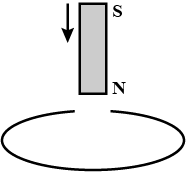Answer
333.9k+ views
Hint: The best example is of a bar magnet moving in a to and fro motion is the solenoid. We are aware of the fact that on moving a bar magnet between the solenoid, a current is induced in it which always opposes the change in the orientation of the bar magnet. In this case, in place of a solenoid, there is a bar magnet going inside the ring and accelerating with an acceleration which is equal to g. Here we will apply this concept and find the correct option.
Complete step by step answer:
In this case, there will be an acceleration when the bar magnet will enter the copper ring. The copper ring is made of metal, this means that when the magnet passes through the axis of the ring a current will be induced in the ring and on applying Lenz law, the current which is induced in the circuit will oppose the change through which it is induced. Thus, the current which is induced inside the copper ring will oppose any change, i.e., it will be opposing the motion of the bar magnet which is going through it and hence the acceleration will decrease.
So, the acceleration will be less than the acceleration due to gravity.
Note: In this case, we have to imagine a ring and a magnet which is going in between the rings. Then, we will apply the concept which was proposed by Emil Lenz. The current which will be induced will oppose the change through which it actually was produced.
Complete step by step answer:
In this case, there will be an acceleration when the bar magnet will enter the copper ring. The copper ring is made of metal, this means that when the magnet passes through the axis of the ring a current will be induced in the ring and on applying Lenz law, the current which is induced in the circuit will oppose the change through which it is induced. Thus, the current which is induced inside the copper ring will oppose any change, i.e., it will be opposing the motion of the bar magnet which is going through it and hence the acceleration will decrease.
So, the acceleration will be less than the acceleration due to gravity.
Note: In this case, we have to imagine a ring and a magnet which is going in between the rings. Then, we will apply the concept which was proposed by Emil Lenz. The current which will be induced will oppose the change through which it actually was produced.
Recently Updated Pages
What are the figures of speech in the poem Wind class 11 english CBSE

Write down 5 differences between Ntype and Ptype s class 11 physics CBSE

Two tankers contain 850 litres and 680 litres of petrol class 10 maths CBSE

What happens when eggshell is added to nitric acid class 12 chemistry CBSE

Why was Kamaraj called as Kingmaker class 10 social studies CBSE

What makes elections in India democratic class 11 social science CBSE

Trending doubts
Fill the blanks with the suitable prepositions 1 The class 9 english CBSE

Difference between Prokaryotic cell and Eukaryotic class 11 biology CBSE

Which are the Top 10 Largest Countries of the World?

Differentiate between homogeneous and heterogeneous class 12 chemistry CBSE

Give 10 examples for herbs , shrubs , climbers , creepers

Change the following sentences into negative and interrogative class 10 english CBSE

Write a letter to the principal requesting him to grant class 10 english CBSE

How do you graph the function fx 4x class 9 maths CBSE

10 examples of evaporation in daily life with explanations




